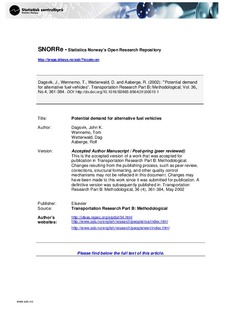| dc.contributor.author | Dagsvik, John K. | |
| dc.contributor.author | Wennemo, Tom | |
| dc.contributor.author | Wetterwald, Dag | |
| dc.contributor.author | Aaberge, Rolf | |
| dc.date.accessioned | 2012-02-07T17:27:19Z | |
| dc.date.available | 2012-02-07T17:27:19Z | |
| dc.date.issued | 2002 | |
| dc.identifier.citation | Transportation Research Part B: Methodological, Volume 36, Number 4, May 2002 , pp. 361-384 | no_NO |
| dc.identifier.issn | 0191-2615 | |
| dc.identifier.uri | http://hdl.handle.net/11250/178084 | |
| dc.description | This is the accepted version of a work that was accepted for publication in Transportation Research Part B: Methodological. Changes resulting from the publishing process, such as peer review, editing, corrections, structural formatting, and other quality control mechanisms may not be reflected in this document. Changes may have been made to this work since it was submitted for publication. A definitive version was subsequently published in Transportation Research Part B: Methodological, Volume 36, Number 4, May 2002 , pp. 361-384. | no_NO |
| dc.description.abstract | This paper analyzes the potential demand for alternative fuel vehicles. The alternative fuel vehicles we consider are liquid propane gas and electric powered vehicles in addition to dual-fuel vehicles. The data were obtained from a stated preference survey in which each respondent, in a randomly selected sample, was exposed to 15 experiments. In each experiment the respondents were asked to rank three hypothetical vehicles characterized by specific attributes, according to the respondents' preferences. Several versions of a random utility model are formulated and estimated. They include a model for rank ordered data, and models that allow for different types of correlation in preferences across experiments. Apart from one case the model specifications are estimated from the data on first choices. The most general model turns out to predict aggregate second and third choices rather well. The model is applied to assess the willingness to pay for alternative fuel vehicles. --Keywords: Random utility; Alternative fuel vehicles; Models for ranking; Serially dependent preferences , Stated preference. | no_NO |
| dc.language.iso | eng | no_NO |
| dc.publisher | Elsevier | no_NO |
| dc.subject | Fuel | no_NO |
| dc.subject | Drivstoffer | no_NO |
| dc.subject | Motorkjøretøyer | no_NO |
| dc.subject | Vehicles | no_NO |
| dc.subject | Etterspørsel | no_NO |
| dc.subject | Norway | no_NO |
| dc.subject | JEL classification: C51 | no_NO |
| dc.subject | JEL classification: C93 | no_NO |
| dc.subject | JEL classification: D12 | no_NO |
| dc.subject | Scientific article | no_NO |
| dc.title | Potential demand for alternative fuel vehicles | no_NO |
| dc.type | Journal article | no_NO |
| dc.type | Peer reviewed | no_NO |
| dc.subject.nsi | VDP::Social science: 200::Economics: 210::Economics: 212 | no_NO |
| dc.source.pagenumber | 361-384 | no_NO |
| dc.source.volume | 36 | no_NO |
| dc.source.journal | Transportation Research Part B: Methodological | no_NO |
| dc.source.issue | Number 4 | no_NO |
| dc.identifier.doi | http://dx.doi.org/10.1016/S0965-8564(01)00013-1 | |
